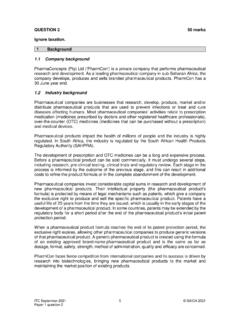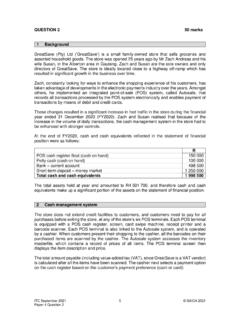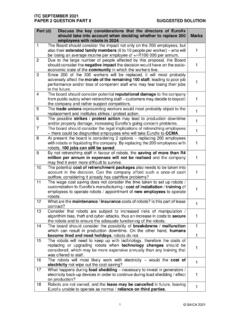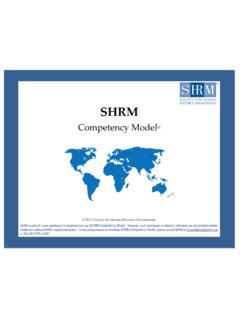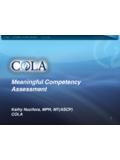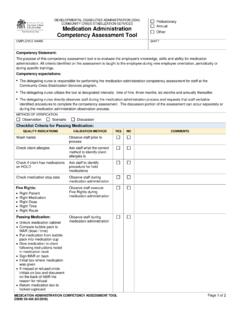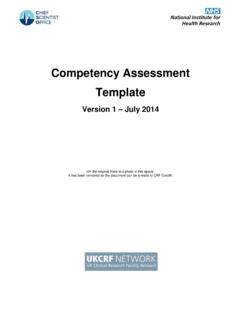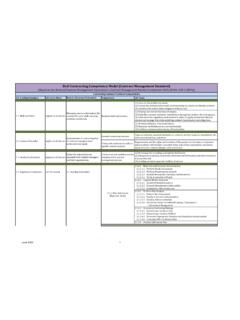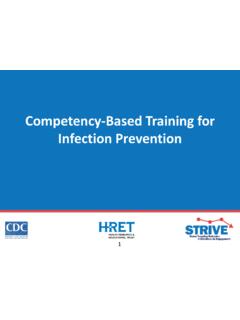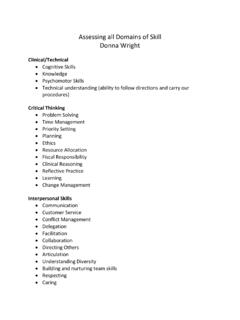Transcription of Guidance for Professional Programmes
1 Guidance for Professional Programmes Competencies of a CA(SA). at the point of the Assessment of Professional Competence THIS DOCUMENT IS APPLICABLE TO. APC 2020 onwards. 1. Contents 1. Introduction .. 3. 2. Overview .. 3. 3. The distinction between knowledge and competency .. 4. 4. Pervasive Qualities and 5. 5. Levels of 6. 6. Knowledge Levels .. 7. 8. Training Contract Levels .. 10. 9. Competencies and their levels by competency Area .. 10. 2. 1. Introduction This document should be read in conjunction with the document entitled: Detailed Guidance to the competency framework for the academic programme.
2 To be found at Become a member > Examinations > Information on what will be examined - on the SAICA website ( ). 2. Overview Pervasive skills: Ethics and professionalism Personal attributes Professional skills Purpose and structure The competency Framework has been adapted to provide Guidance for academic Programmes which prepare students for SAICA's Part I examination. This Guidance is provided in this document ( competency Framework Detailed Guidance for Academic Programmes ) and takes the following form: competency areas: These are the overall pervasive and specific competencies (e.)
3 G. Financial Management, Taxation, etc.). Levels of proficiency definition: These levels have been defined for each competency within the specific competencies. Definitions of proficiency are included in the introduction to each specific competency area. Levels of proficiency competencies: A level of proficiency has been determined for each competency within all of the specific competency areas. 3. Knowledge reference list: A knowledge base which underlies the competencies has been developed for each of the specific competency areas.
4 This knowledge reference list includes the minimum topics which should be included in the academic Programmes which prepare students for SAICA's QE Part I. Knowledge levels: Knowledge is only one element of proficiency and therefore knowledge levels are described differently from proficiency levels. A knowledge level is indicated for each item identified in the knowledge reference list. Examinable pronouncements Accounting and External Reporting / Auditing and Assurance / Taxation: A list of examinable pronouncements with an indication of knowledge levels will be provided in a separate document (available from SAICA).
5 This document is updated annually in October for the following years ITC. The purpose of a separate list of examinable pronouncements is to provide clear Guidance to both examiners, academics preparing students and ITC candidates on an annual basis. 3. The distinction between knowledge and competency competency competency is defined in this document (see page 17) as The particular tasks that CAs perform while applying, or bringing to bear, the pervasive qualities and skills that are characteristic of CAs to the level of proficiency defined as appropriate by the profession.
6 Proficiency levels that are assigned to the competencies in this document set out what should be reasonably expected of candidates who have completed the academic programme but who have not yet embarked upon the Professional and training Programmes . competency can also be viewed as the ability to execute a task in the real world . In order to acquire a competency a candidate must . - acquire knowledge - develop understanding - have experience of executing tasks (practical application). These steps are usually not discrete but are rather aspects of an integrated process.
7 Knowledge and understanding A knowledge base provides a foundation for the development of the competencies described in the competency Framework. This foundation not only requires knowledge but also understanding ( not rote learning or memorisation). Although the knowledge foundation for a particular competency should be evident from close examination of the competencies, a content list is provided for each of the specific competency areas (in the form of a knowledge reference list) in order to provide Guidance for providers of the academic programme.
8 4. Executing tasks (practical application). Knowledge and understanding alone do not result in competency . The opportunity to apply knowledge and understanding in practical circumstances is indispensable for the acquisition of a competency . There is little, if any, opportunity in the academic programme for practical application of knowledge and understanding. There is ample opportunity, however, for application through various forms of contextualised questions (mini case studies). These attempts to replicate practical application to the extent possible in an academic environment.
9 For purposes of competency acquisition in academic Programmes it is fully accepted that experience in executing tasks will usually be through contextualised questions and mini case studies. 4. Pervasive Qualities and Skills Ethical Behaviour and Professionalism [IA] and Personal Attributes [IB]: Many of these qualities and skills should be addressed in both the education (academic and Professional ). and training Programmes . It is expected that candidates should demonstrate the highest level of proficiency for these qualities and skills by the time they enter the profession ( after completion of all education, training and assessment requirements).
10 Levels of proficiency to be achieved for these pervasive skills in the academic programme are not prescribed as it is acknowledged that objective measurement of levels of proficiency achieved in the academic programme is difficult to determine. It is also recognised that some qualities and skills may be better addressed in the training programme. Providers of the academic programme are expected to address all those qualities and skills which, in their opinion, are suitable for inclusion in the academic programme. Providers will be required to explain how these qualities and skills are addressed and provide full motivation for excluding any from the academic programme.

